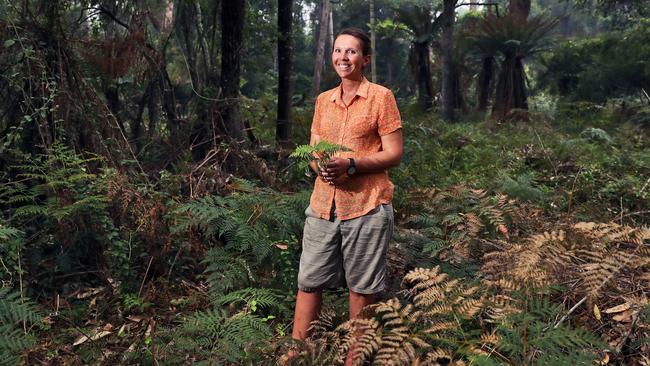Last stand to save Wollemi pines from inferno
When Heidi Zimmer first searched for a PhD topic in 2010, her supervisor proposed the idea of studying the Wollemi pine.

When Heidi Zimmer was casting about for a topic in 2010, she received an email from her supervisor asking if she’d be interested in doing her PhD on the Wollemi pine.
“I still have that email,” says Ms Zimmer, now a NSW government ecologist. “I wrote back ‘Yes!’ followed by several hundred exclamation marks.”
For people who love and understand plants the Wollemi pine — the dinosaur pines discovered in 1994 in a forest just a few hundred kilometres from Sydney’s CBD — is more than just a tree. It’s existed on Earth for more than 200 million years, surviving dinosaurs, meteors, ice ages and savage drought. It became extinct millions of years ago everywhere on the planet but for this one deep canyon in the Wollemi National Park. Fewer than 100 mature trees remain in the wild.
For plant lovers, the Wollemi is a rainforest Rembrandt, a biological treasure of unfathomable value.
Ms Zimmer, 35, devoted years to its study, then, in the lead up to Christmas, she watched from afar as the rapacious Gospers Mountain fire raced towards the wild Wollemi grove. She was in the scrub, doing fieldwork outside Orange, when the name David Crust lit up her phone. Mr Crust is the manager of the Blue Mountains parks. “I thought ‘Goodness gracious me, this must be it!’”
Can you go tonight, Mr Crust asked? Yes, of course. “I put down the phone and had a thousand things running through my head like, ‘I’d better call Mum and Dad to see if they can look after baby Oscar (her 18-month-old son)’,” she said.
Ms Zimmer was drafted into a team with the secret mission to save the pines. Despite the very real dangers, no one who was asked hesitated, not least the mother of a young child. “Everything I want to say about the pines seems like a cliche,” she said. “They mean the world to me. I guess I love them.”
The plan was to set up a sprinkler system in the main Wollemi grove, to moisten the leaf litter beneath the trees. Meanwhile, aircraft would lay fire retardant in the path of the advancing fire while helicopters bucketed the canyon with water. The entire operation would be carried out as one of the most savage fires this country has ever seen rampaged towards them.
Ms Zimmer and her colleagues were winched in, near the grove, then had to abseil down to the pines. At one point, burning ash began raining down on them.
“It was frightening, if you thought about it, but I knew we had a helicopter on standby,” she said. “Besides, I didn’t want to be ‘the girl’.”
It would take a remarkable team effort from Ms Zimmer and others to lay the groundwork to be ready for onslaught of the fire. “When we got the pumps up and running it was actually very beautiful, the sprinklers were casting these drops of water and there were little rainbows everywhere.”
The seedlings, the subject of her PhD, were burned to a cinder when the fire swept through, but all the mature trees in the grove were saved. “We’ll get a seed fall, hopefully in February,” she says.
Saving the pines was a rare victory for nature in this summer of humiliating defeats.




To join the conversation, please log in. Don't have an account? Register
Join the conversation, you are commenting as Logout